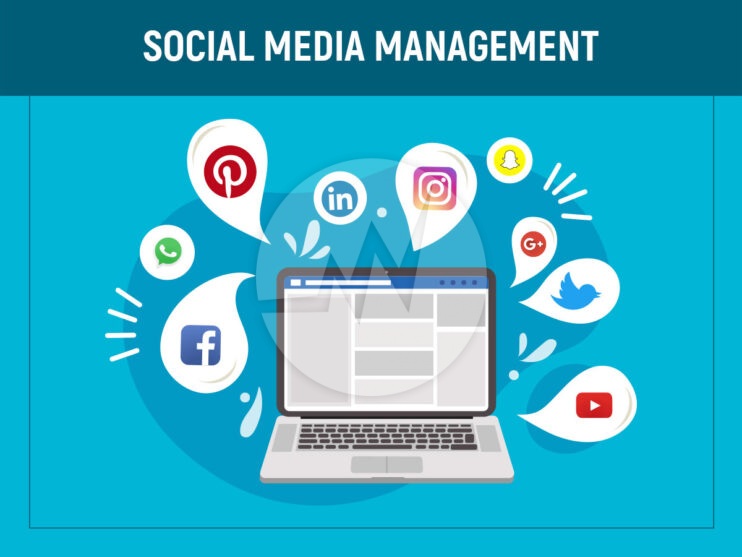Build the Right Social Media Marketing Strategy for your business!

Tips for a sustainable social media strategy
Many smaller companies or sole proprietorships hesitate when it comes to using social networks for their business. The self-employed and employees of smaller companies in particular suffer from chronic time constraints and cannot imagine how they should also use the various social media appearances. Some also feel pressured because they know that their company should be visible on social media and that they won’t make it. Some also think they don’t know their way around well enough and don’t even get started.
Or they just get started and are then a little disappointed when it doesn’t succeed. There is nothing bad about it if you just do things and try things out. However, if you don’t dare to do it, your company’s visibility won’t improve either.
Before you jump into the social networks, you should definitely make a few thoughts. A social media marketing strategy helps you select the right social networks and content and better estimate the time required.
1. What do you want to achieve with the social media presence?
Think about what the goal of the social media presence is. Why exactly for you want to open a fan page or a Facebook group or be active on LinkedIn? Possible goals are, for example:
- Do you want to become known yourself or make your product / service known?
- Do you want to spread your blog articles there?
- Do you want to generate more visitors for your website?
- Do you want to exchange ideas with your customers and prospects?
- Do you want access to information?
What doesn’t work well is selling! Many entrepreneurs believe that they can use social networks to quickly set up a sales platform. That will probably not work, because first you have to get fans and followers, build trust and offer added value. There is a reason why social networks are called “social” media. They are based on the network concept and social selling, i.e. through dialogue and exchange with others.
Set measurable and realistic goals and set relevant performance indicators, for example quantitative goals such as “x% more ecommerce store sales through Facebook users” or qualitative ones such as “how many positive mentions we had within a certain period of time”. Every company has to set its own goals.
2. Who is your target group?
Identify your target groups and think about which new target groups you could reach. The more precisely you determine your target groups, the easier it is for you to choose the appropriate networks. Do not only define target groups based on socio-demographic characteristics such as age, gender, place of residence, etc. It is much more important to define so-called “buyer personas”. These are fictional people whose description goes far beyond the target group definition. It’s about finding out people’s interests, goals, desires, and expectations. Personas are therefore typical customers with their behavioural patterns and challenges. The more intensively you deal with the target groups, the easier it will be for you to address your customers correctly and to find content for social networks.
Because one thing is important: the target groups determine the content! When you know who you’re writing for, it will be much easier for you to come up with ideas for your content.
3. Which social media platform do you consider?
Choose the right social media platform for your goals and target groups. Where can you best communicate with your target groups? Don’t just think about Facebook.
It has become more and more difficult in Facebook in recent years to be seen without advertisements with your own posts on the fan page. This lack of reach is very frustrating for many and not everyone has a significant budget for advertising. Since Facebook changed the algorithm some time ago so that posts from friends and groups are preferred, it has become questionable whether a fan page is still attractive. However, a presence on Facebook is definitely part of a well-rounded social media strategy. Perhaps you can also discuss with your target group in a group you have opened. At the same time, you strengthen your expert status.
LinkedIn may be better suited for business customers, but don’t underestimate Instagram, for example. There are not only young target groups available there and the high number of active users means that good coverage can often be achieved. However, Instagram can only be played on well if you have good picture material. These don’t necessarily have to be photos or videos; they can also be graphics. A consistent visual language is definitely part of it.
4. How are you perceived on social networks?
If you are active with your company in several social networks, it is worth thinking about the “branding”. It doesn’t always have to be the same image, which is difficult if only because each network has different image sizes. Besides, you may have a different purpose in each network. But the recognition value simply has to be given. This can be the logo, a similar visual language or image structure. It is certainly not a waste of money asking a graphic designer for assistance. What also plays a role in how you are perceived is the tonality, i.e. your voice in the social networks.
5. What is the added value of your social media profile?
What is the added value the fan page or the company’s presence on social networks and why should people follow you? It is really worth it if you give this thought to yourself. Publishing press releases or pictures of the last company party are not about to added value. The latter might pass as “authentic”, but only if you provide really useful information. Authenticity is a very big issue in social networks. Of course, coming across as authentic doesn’t mean that you make a live video on Facebook in a jogging suit. It means being credible, not copying others, and writing good content on a regular basis. You can also show your personality on social networks, but of course there is a difference between personal and private statements.
There are many ways in which you can add value: useful tips, how-to, updates, instructions, information about new blog articles, support, curated content, etc. Simply posting articles that offer no added value will keep you going for a long time. Don’t really get your vision any further.
6. Visual storytelling and social media marketing
Visual storytelling and social media marketing – this is how you present your company in a targeted manner with pictures in the social networks. This is about how sole proprietorships and companies can present themselves effectively and professionally with pictures and videos in social networks. Individual topics are e.g.
- How to develop a consistent visual language?
- What is visual storytelling and what do I have to consider?
- What are the best social media strategies?
- Which social media networks can I best use and how?
7. What content will you provide?
Think about content that is relevant to your target audiences. What can you tell, do you have good visual material? Incidentally, many social media beginners think that they should not post any third-party content on their fan page/profile, because this supports the “competition”. There are two things at stake here: first of all, it is called “social media” because you exchange ideas, not only with your customers/prospects, but also with your colleagues/competitors. Second, you curate content for your fans. It’s just a give and take. If someone posts something interesting that is also relevant to your fans, then that’s great. And maybe you have a post that will then also be shared by the others and in this way increase your reach.
8. How much time can you spend on social media support?
Plan the resources, such as time and budget. If you’re a one-man business, you should set yourself a timeframe and stick to it to keep you going. Use an editorial plan to plan your posts to determine what you want to publish, when and on which social network. In these plans, the holidays are often entered in advance. If you now enter your important relevant dates on which you want to inform your fans/followers about certain topics, all the better.
You can collect ideas for your social media posts in tools and use an editorial plan. Of course, you first have to find out which tool is suitable and which one suits you. We advise a beginner to post manually first, also to get to know the special features of the individual social media, to use the right image sizes, etc.
No cross-posting despite time savings
Of course, it saves time if you connect the social media networks with each other and a post in Facebook is also automatically published in Twitter or a picture in Instagram is automatically published in Facebook. But on each network, posts look different and the image sizes are different. A post that is perfect on one network may look weird on another. Posts automatically posted on Facebook by Instagram do not work well, as all hashtags that are irrelevant to Facebook can then be seen. A post posted by Facebook on Twitter looks really bad. That should be avoided.
9. Do you have a well-kept, up-to-date company profile?
Create complete company profiles and network them with each other if possible. This means the possibility of entering all of your other profiles on social platforms. LinkedIn has developed a lot and there are many new ways to present yourself, for example with “featured articles” and the possibility of integrating images, PDFs, videos etc. So, it is worth going through the profiles from time to time and updating them. This is extremely important, especially if you are a “personal brand”, because you want to be seen as an expert.
10. Do you measure the success of your social media engagements?
Social media management and monitoring can be very time consuming. Basically, measuring success and optimizing is just as much a part of the craft as defining goals and key figures. Every social media channel has its own statistics, which give you information about the reach, posts clicked, fan/follower growth and much more. Social media management tools have the advantage that the statistics of all channels can then be viewed in one tool, which saves time.
However, not everything can be measured using these tools. For example, if your goal is to generate more traffic for the website, you need a web analysis tool such as Google Analytics with which you can evaluate how many visitors came via the social networks.
Of course, there are many tried and tested ways of using which strategy and tactics to be successful on social media. But in the end, you always have to look at the statistics and measure, test and optimize success.
11. Learn the rules of the game!
If you have little experience in dealing with social networks, you can first register with a private profile. See how it is communicated and where, which mistakes in Facebook should be avoided, what the competition is doing and where there are good examples from your industry. Especially at the beginning you need a lot of time to familiarize yourself with the networks and to learn the rules of the game. Also get actively involved in the groups in order to become “visible”, but please do not post any advertising there – that is usually not well received.
Conclusion
The following applies to self-employed and small business: Register! Participate! Communicate! You can only win thereby. Social media is more than just winning new customers or increasing your image, don’t forget to have fun with it! First get to know the rules of the game in the respective network with a private profile and try to network with others. Then create a social media strategy for your company or personal brand.
Think of the social media strategy as long-term. It is important that you don’t allow yourself to be put under pressure. You don’t have to be represented in every social network. It is better to concentrate on a well-maintained presence in one network than only half-heartedly recorded company profiles in five different networks.
If you are looking for Social Media Marketing, Content Marketing Strategies, Search Engine Optimization Services, Digital Marketing Services, PPC Campaign Management Services and more, Please Explore our SEO Services!





